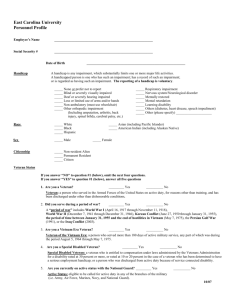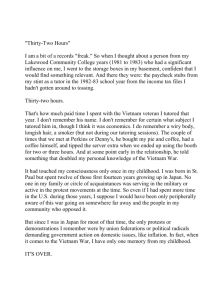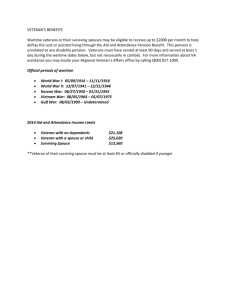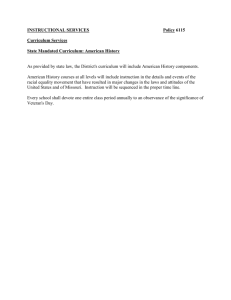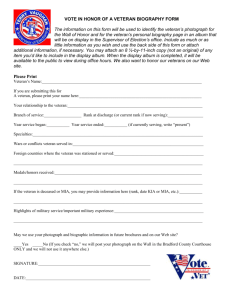Citation Nr: 9830193 - Blue Water Navy Vietnam Veterans Association
advertisement
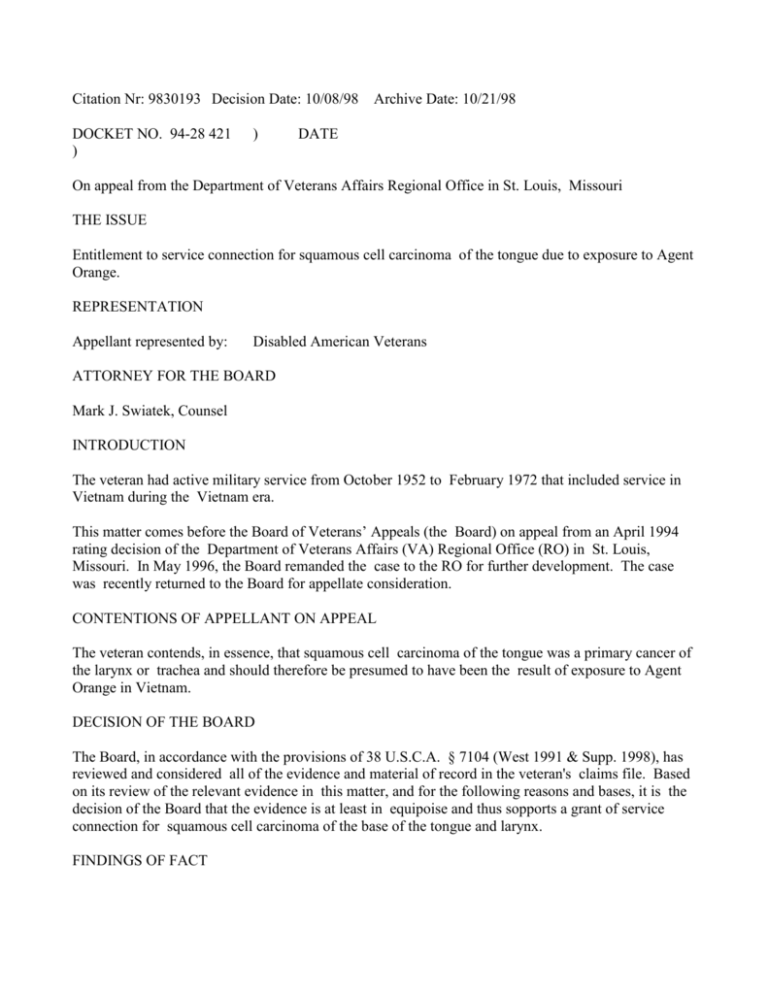
Citation Nr: 9830193 Decision Date: 10/08/98 DOCKET NO. 94-28 421 ) ) Archive Date: 10/21/98 DATE On appeal from the Department of Veterans Affairs Regional Office in St. Louis, Missouri THE ISSUE Entitlement to service connection for squamous cell carcinoma of the tongue due to exposure to Agent Orange. REPRESENTATION Appellant represented by: Disabled American Veterans ATTORNEY FOR THE BOARD Mark J. Swiatek, Counsel INTRODUCTION The veteran had active military service from October 1952 to February 1972 that included service in Vietnam during the Vietnam era. This matter comes before the Board of Veterans’ Appeals (the Board) on appeal from an April 1994 rating decision of the Department of Veterans Affairs (VA) Regional Office (RO) in St. Louis, Missouri. In May 1996, the Board remanded the case to the RO for further development. The case was recently returned to the Board for appellate consideration. CONTENTIONS OF APPELLANT ON APPEAL The veteran contends, in essence, that squamous cell carcinoma of the tongue was a primary cancer of the larynx or trachea and should therefore be presumed to have been the result of exposure to Agent Orange in Vietnam. DECISION OF THE BOARD The Board, in accordance with the provisions of 38 U.S.C.A. § 7104 (West 1991 & Supp. 1998), has reviewed and considered all of the evidence and material of record in the veteran's claims file. Based on its review of the relevant evidence in this matter, and for the following reasons and bases, it is the decision of the Board that the evidence is at least in equipoise and thus sopports a grant of service connection for squamous cell carcinoma of the base of the tongue and larynx. FINDINGS OF FACT 1. The veteran had service in the Republic of Vietnam during the Vietnam era. 2. Squamous cell carcinoma of the tongue and supraglottic larynx manifested in 1983, approximately 16 years after Vietnam service ended in 1967, may reasonably be related to exposure to Agent Orange in service. CONCLUSION OF LAW Squamous cell carcinoma of the tongue and supraglottic larynx may be presumed to have been incurred in service on the basis of exposure to Agent Orange in service. 38 U.S.C.A. §§ 1110, 1131, 1116, 5107 (West 1991 & Supp. 1998); 38 C.F.R. §§ 3.307, 3.309, 3.313 (1998). REASONS AND BASES FOR FINDINGS AND CONCLUSION Service connection may be granted for a disability resulting from personal injury or disease contracted in the line of duty. 38 U.S.C.A. §§ 1110, 1131. Service in Vietnam includes service in the waters offshore, or service in other locations if the conditions of service involved duty or visitation in Vietnam. 38 C.F.R. § 3.313. Diseases associated with exposure to certain herbicide agents. (i) For the purposes of this section, the term "herbicide agent" means a chemical in an herbicide used in support of the United States and allied military operations in the Republic of Vietnam during the period beginning on January 9, 1962, and ending on May 7, 1975, specifically: 2,4-D; 2,4,5-T and its contaminant TCDD; cacodylic acid; and picloram. (ii) The diseases listed at § 3.309(e) shall have become manifest to a degree of 10 percent or more at any time after service, except…respiratory cancers within 30 years, after the last date on which the veteran was exposed to an herbicide agent during active military, naval, or air service. (iii) A veteran who, during active military, naval, or air service, served in the Republic of Vietnam during the period beginning on January 9, 1962, and ending on May 7, 1975 and has a disease listed at § 3.309(e) shall be presumed to have been exposed during such service to an herbicide agent, unless there is affirmative evidence to establish that the veteran was not exposed to any such agent during that service. The last date on which such a veteran shall be presumed to have been exposed to an herbicide agent shall be the last date on which he or she served in the Republic of Vietnam during the period beginning on January 9, 1962, and ending on May 7, 1975. "Service in the Republic of Vietnam" includes service in the waters offshore and service in other locations if the conditions of service involved duty or visitation in the Republic of Vietnam. Rebuttal of service incurrence. Evidence which may be considered in rebuttal of service incurrence of a disease listed in § 3.309 will be any evidence of a nature usually accepted as competent to indicate the time of existence or inception of disease, and medical judgment will be exercised in making determinations relative to the effect of intercurrent injury or disease. The expression "affirmative evidence to the contrary" will not be taken to require a conclusive showing, but such showing as would, in sound medical reasoning and in the consideration of all evidence of record, support a conclusion that the disease was not incurred in service. 38 C.F.R. § 3.307(a)(6), (d). Disease associated with exposure to certain herbicide agents. If a veteran was exposed to an herbicide agent during active military, naval, or air service, the following diseases shall be service-connected if the requirements of § 3.307(a)(6) are met even though there is no record of such disease during service, provided further that the rebuttable presumption provisions of § 3.307(d) are also satisfied…respiratory cancers (cancer of the lung, bronchus, larynx, or trachea), soft-tissue sarcoma (other than osteosarcoma, chondrosarcoma, Kaposi's sarcoma, or mesothelioma). Note 1: The term "soft-tissue sarcoma" includes the following: Adult fibrosarcoma, Dermatofibrosarcoma protuberans, Malignant fibrous histiocytoma, Liposarcoma Leiomyosarcoma, Epithelioid leiomyosarcoma (malignant leiomyoblastoma) Rhabdomyosarcoma, Ectomesenchymoma, Angiosarcoma (hemangiosarcoma and lymphangiosarcoma), Proliferating (systemic) angioendotheliomatosis Malignant glomus tumor, Malignant hemangiopericytoma, Synovial sarcoma (malignant synovioma), Malignant giant cell tumor of tendon sheath, Malignant schwannoma, including malignant schwannoma with rhabdomyoblastic differentiation (malignant Triton tumor), glandular and epithelioid malignant schwannomas, Malignant mesenchymoma, Malignant granular cell tumor Alveolar soft part sarcoma, Epithelioid sarcoma, Clear cell sarcoma of tendons and aponeuroses, Extraskeletal Ewing's sarcoma, Congenital and infantile fibrosarcoma Malignant ganglioneuroma. 38 C.F.R. § 3.309(e). The Board has reviewed the record carefully in light of the law and regulations as set forth herein. Initially, the Board observes that the veteran has presented evidence of a well grounded claim for service connection based upon the presumptive provisions of 38 C.F.R. §§ 3.307 and 3.309; that is, the claim is plausible or capable of substantiation. It is accompanied by supporting evidence rather than solely on the basis of allegation alone. Tirpak v. Derwinski, 2 Vet. App. 609, 611 (1992); Murphy v. Derwinski, 1 Vet. App. 78, 81 (1990). The Board finds the veteran’s Navy service as a member of Patrol Squadron 17 during 1966 and 1967 for which the was authorized to wear the Vietnam Service Medal and Vietnam Campaign Medal with Device 1960 is qualifying service as defined under 38 C.F.R. §§ 3.307(a)(6)(iii) and 3.313. There is as well competent medical evidence in support of the claim. Further, the Board finds that the record as it now stands is adequate for an informed determination and that the duty to assist has been fulfilled. The RO conscientiously completed the development asked for by the Board remand and obtained medical opinions from VA pathology and oncology specialist and other pertinent evidence. In view of the medical evidence, there appears to be agreement that the veteran’s tumor was a squamous cell carcinoma. The record shows that the representative asserted the veteran had a soft tissue sarcoma. However, there is no medical evidence reporting the diagnosis, and squamous cell carcinoma is not among the disorders within the regulatory definition of soft tissue sarcoma. In order for the veteran to prevail, it is only necessary that the probative evidence for and against the claim be in relative equipoise. The favorable evidence need not outweigh that which is unfavorable for the veteran to be entitled to the benefit of the doubt. To deny the claim would require that the evidence preponderate against it. Alemany v. Brown, 9 Vet. App. 518, 519-20 (1996). In other words, in this case it would have to be established by a preponderance of the competent evidence that the tumor of the base of the tongue was not a primary tumor of the lung, larynx, bronchus or trachea or, if so, that affirmative evidence rebutted the presumption in favor of service connection based upon exposure to herbicides (Agent Orange). The veteran had the required service and the tumor was manifested within the applicable time period. The Board in remanding the case sought to establish the primary site of the tumor through medical evidence as this was a significant element that was not clearly established in the record available in 1996. See also VAOPGCPREC 18-97 (O.G.C. Prec. Op. 18-97, 62 Fed. Reg. 37954 (1997). The Board is bound by the precedent opinions of the VA General Counsel. 38 U.S.C.A. § 7104. In summary the evidence shows that the squamous cell carcinoma was initially reported in the early 1980’s. David W. Moore, M.D., opined in 1996 that it was debatable as to whether the veteran’s tumor, which he identified as squamous cell carcinoma of the base of the tongue and supraglottic larynx, was a primary in the supraglottic larynx or base of the tongue as it was a very large squamous cell carcinoma that involved both the epiglottis and base of the tongue. A VA pathologist reported in 1997 that the tumor appeared to arise from the base of the tongue and encroach upon the epiglottic root without laryngeal involvement. And, thereafter, it was the opinion of a VA oncologist that the probability of the tumor originating from the glottic area “should be” less than 10 percent. The conclusions of Dr. Moore and the VA oncologist and pathologist appear to have been based on a fair consideration of the material evidence, and to reflect significant knowledge and skill in analysis of the pertinent data. Alemany, 9 Vet. App. at 519. As with any piece of evidence, the credibility and weight to be attached to a medical opinion is an adjudication determination. Guerrieri v. Brown, 4 Vet. App. 467, 470-71 (1993). The Board must assess the weight and credibility to be given to the evidence. Sanden v. Derwinski, 2 Vet. App. 97, 101 (1992). From the perspective of ultimate weight, Dr. Moore’s opinion in 1996 of a supraglottic larynx primary for the veteran’s squamous cell carcinoma can reasonably be accorded significant probative weight as it was based upon the assessment of the surgeon who removed the tumor and was aware of its characteristics. He related the characteristics of the tumor, it size and area of involvement, that supported his conclusion in favor of a supraglottic primary. The pertinent data were specific to the veteran’s case rather than general observations. The VA pathologist was not definite as to a likely primary site stating that the tumor “appears” to be arising from the base of the tongue. The Board does not find the opinion of the VA oncologist outweighs the favorable evidence either alone or in combination with the pathologist’s opinion. In essence, the oncologist opined that the likelihood of a glottic area primary was less than 10 percent. However, the question that must be addressed is, in essence, whether the evidence would tend to place the veteran within the 10 percent group that may have a glottic primary. Smith v. Brown, 8 Vet. App. 546, 553 (1996). Viewing this medical evidence objectively, the Board is left with the belief that Dr. Moore’s opinion is not outweighed by the VA medical opinions and viewed together they do not preponderate against the claim on this point. The VA pathologist, as noted previously, is equivocal as to the primary site and the oncologist does not offer an opinion on the probability of the veteran being within the 10 percent who may have a glottic primary. Dr. Moore does offer credible evidence in support of a supraglottic larynx primary. Therefore, the Board concludes that the evidence, viewed objectively, is at least in equipoise as to the primary site of the squamous cell carcinoma. The Board also finds that the rebuttal provisions of § 3.307 are satisfied. Although the information recorded during the veteran’s medical evaluation in 1983 does note a smoking history, the record does not offer a definite or obvious etiology to refute the possible herbicide etiology by a preponderance of the evidence. Alemany, 9 Vet. App. at 519. Having reviewed the evidence, the Board finds that the elements necessary to establish service connection for squamous cell carcinoma of the base of the tongue and supraglottic larynx as a residual of Agent Orange exposure have been met as a preponderance of the evidence is not against the claim. ORDER Service connection for squamous cell carcinoma of the tongue and supraglottic larynx due to exposure to Agent Orange is granted. ROBERT E. SULLIVAN Member, Board of Veterans' Appeals
